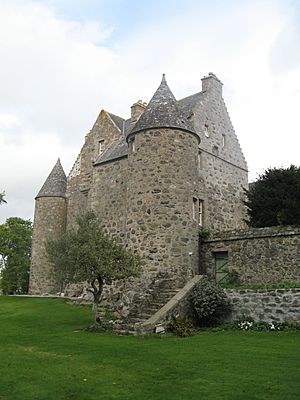Barra Castle facts for kids
Barra Castle is a special kind of castle called an L-plan tower house. It was built a long time ago, in the early 1500s. You can find it about two miles south of Oldmeldrum in Aberdeenshire, Scotland. The castle sits above the Lochter Burn. This spot is famous because it's where the Battle of Inverurie (1308) happened. In this battle, Robert the Bruce won against John Comyn, Earl of Buchan.
Contents
History of Barra Castle
Early Owners and Changes
A castle has stood on this site since the mid-1200s. At that time, it was home to the King family. Later, in 1598, George Seton was given the land. He was an important person, a chancellor at the University of Aberdeen.
A special document from 1599 said that Barra's lands would become a "free barony." This meant it was a special area with its own rules. Another document in 1615 stated that the "fortalice of Barra" (meaning the castle) would be the main building of this barony.
New Families and Updates
By 1630, James Reid, a lawyer from Aberdeen, owned the castle. The Reid family kept it until 1754. During their time, Dame Margaret Abercrombie, whose husband John Reid became a baronet, updated parts of the house. She might have added the fireplace in the Great Hall.
In 1754, John Ramsay bought the castle. He was a merchant who traded in Russia. He added a new section to the north side of the castle. His family still owns Barra Castle today. Later, in the early 1900s, a Ramsay family member married Andrew Irvine.
John Ramsay liked his other estate, Straloch, more. After he passed away in 1787, Barra Castle was used as a farmhouse. But in the early 1900s, it was restored. It became a "dower house," which is a home for a widow. George Bennet Mitchell designed the restoration plans.
What Barra Castle Looks Like
Castle Layout and Towers
Barra Castle has an unusual L-plan shape. The main part of the castle runs from north to south. There's a round tower on the southwest side. Another tower, shaped like a "D," is on the southeast. This D-shaped tower holds the main staircase and the entrance. The top of this tower becomes square, forming a lookout spot. It connects to a large square wing. This wing also has another round tower on its northwest corner.
The main entrance to the castle is in the inner corner where the two parts of the "L" meet. The towers all have pointed, cone-shaped roofs.
Later Additions and Materials
An extra section was added to the east side of the main castle in the 1700s. A wall to the east completes a square courtyard. The buildings around this courtyard are three stories tall. They are built from rough, strong stones called "pinned boulder rubble." The main gables (the triangular parts of the walls at the roof's end) have a stepped design called "crow stepped."
Inside, the drawing room has wooden panels and a large fireplace. A smaller fireplace was added later inside it. A bedroom on the first floor of the southeast wing also has wooden panels from the 1700s. There's another panelled sitting room in the north wing.
Barra Castle is a very important historic building. It is a category A listed building. This means it has special historical or architectural value. The castle stands on the same spot where Robert the Bruce won his important battle in 1308. The Hunterian Museum in Glasgow even has an old hammerstone found at Barra Castle.
Paintings of the Castle
Two paintings of the inside of Barra Castle were made by James Cassie. You can see them at the Aberdeen Art Gallery:
Images for kids





